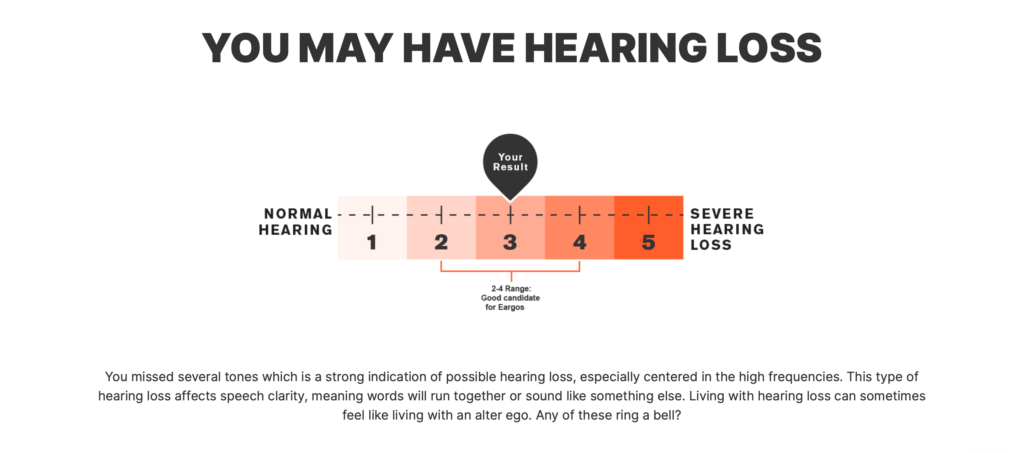Best Online Hearing Tests That Are Free
An online hearing test checks for hearing loss in 3–10 minutes. To assess your hearing, you'll need headphones or earbuds.
Best Online Hearing Tests That Are Free
Hearing loss doesn’t discriminate and can affect people of any age. An online hearing test can be a helpful first step in figuring out if you have hearing loss. Our expert review will tell you everything you need to know to find the best online hearing test.
Products carousel
- Editor’s Choice & Best for simplicity: Jabra Enhance
- Best follow-up: Audicus
- Best for tone testing: Eargo
- Best online hearing test with audiogram: MDHearing
- Best overall: Signia
- Best rapid test: Phonak
- Best for mild hearing loss: Miracle-Ear
- Best from over-the-counter retailers: Best Buy
Who Should Take an Online Hearing Test?
Maybe a friend or partner has complained that they need to repeat themselves around you. Or maybe you’re finding yourself having trouble with conversations in some settings.
Take an online hearing test if: You think you may have any degree of hearing loss.

How Online Hearing Tests Work
Most online tests will ask you some initial questions about your hearing and demographics. You’ll then be presented with sounds of various frequencies and prompted to adjust the sound level or say whether you can hear a particular sound at a specific frequency.
The format can differ slightly from test to test, but tests generally assess your hearing ability to detect pure tones. As Dr. Kim points out, online tests only assess one component of your hearing.
What Is an Audiogram?
An audiogram is a graph that displays the results of a specific type of hearing test called a pure-tone test. A pure-tone test is the kind of test administered by most online tests.
It shows whether you have trouble hearing specific frequencies. For example, during testing, our tester received consistent results that they had potential mild hearing loss in their right ear, specifically in the case of low frequencies.
But an audiogram has its limitations. According to one 2017 review, an audiogram only provides information about hearing sensitivity, not how you process sound.
Taking an Online Hearing Test
When taking an online hearing test, you’ll want to:
- Sit in a quiet room.
- Eliminate distractions.
- Turn off any noisy appliances (e.g., air conditioner, fan, etc.).
- Use quality equipment like a good pair of headphones.
Choosing an Online Hearing Test

Make sure the test is free: There’s no reason to pay for an online hearing test. Don’t take a test if a company claims to have a superior option and requests a fee. There is no online test that can replace an in-person exam, and there are plenty of online options to choose from if you’re looking for a basic understanding of your hearing ability.
How We Chose the Best Online Hearing Tests
We determined our top picks based on the following criteria:
- Easy-to-follow setup and format
- Customer care
- Free access
- Registration process
- Results processing time
- Equipment needed
Online Hearing Tests
- Cost: Free
- Equipment needed: Headphones
- Results processing time: Results via email
This simple online hearing test from Jabra Enhance checks hearing ability in both your right and left ear and provides detailed information about what your results mean. For example, one result suggests unilateral hearing loss and difficulty hearing low-frequency sounds. If you also get this result, you may struggle in group conversations or noisy environments, according to the results page. Sounds may abandon their fullness, causing music or voices to sound “thin.”
The downside is that you do need to fill out your name, email, and phone number to even get your hands on any results.
Pros
-
Simple to take and includes a practice round
Cons
-
Need to fill in email and phone number to get results
- Cost: Free
- Equipment needed: Headphones
- Results processing time: Via email
If you know you want someone to follow up with you after your test, we recommend taking the Audicus online hearing test. You’ll need to fill out some personal information and provide your phone number and email, then you’ll be taken through the hearing test. The test will then play tones and prompt you to hit the spacebar when you hear a tone. After the test, you’ll be asked a few hearing-related questions before receiving results via email.
This one took the longest of the tests we tried and wasn’t as intuitive. The results were inconclusive, requiring us to redo an entire section at one point. That said, we appreciate the prompt and personalized follow-up. If you prefer not to be contacted, though, this probably isn’t the online hearing test for you.
Pros
-
Immediate follow-up with the customer
Cons
-
Process is longer than other tests
-
Phone number and Email required
- Cost: Free
- Equipment needed: Headphones
- Results processing time: Instant
A thorough setup process ensures that you’re all set to receive accurate results. The process involves a hand rubbing calibration step that’s unique to this test. It ensures you have your device volume set correctly.
Like the Audicus test, the Eargo test plays tones and asks you to click the button anytime you hear a sound. Tests like these are helpful for people who might not think they have hearing loss and might be swayed to fib when prompted if they hear a particular sound. But they can also be difficult for those who have trouble focusing. Another advantage is that Eargo encourages you to book a phone telecare checkup once you’re done with the test.
To access your instant results, you’ll need to share your name, email, and phone number. One thing to point out is that we received multiple Eargo marketing emails after completing this hearing test. You can easily unsubscribe but skip this one if junk mail bothers you.
Pros
-
Thorough setup process
-
Helpful follow-up with customer service
Cons
-
Not as intuitive as other tests
-
Phone number required
-
Too many marketing emails
- Cost: Free
- Equipment needed: Headphones
- Results processing time: Via email
This MDHearing online hearing test is one of the only tests we tried that provides the user with an audiogram. It’s also capable of detecting single-ear hearing loss. One downside is that you need to enter a valid US phone number to take the test, which some people might not feel comfortable doing.
You also need to provide your email so you can see your results. However, all-in-all the test is comprehensive as far as online tests go and easy to complete.
Pros
-
Provides you with an audiogram
-
Free consultation post-test
Cons
-
Need to provide phone number and email
- Cost: Free
- Equipment needed: Headphones
- Results processing time: Instant
Our reviews team found this to be the best online hearing test, no email required! The Signia online hearing app is our pick for the best overall hearing aids app because it’s easy to use, has a simple yet comprehensive format, and doesn’t require you to input any personal information.
The test also asks you what kind of headphones you’ll be using to make sure you hear sounds properly. It’ll prompt you to adjust your volume to 100%, but don’t assume this is the case with all tests. Always start with your volume at a comfortable level and only change it when prompted.
Pros
-
Easy-to-follow
-
Intuitive format
-
No need to fill out any personal details
Cons
-
None of note
- Cost: Free
- Equipment needed: Headphones
- Results processing time: Instant
You can complete this intuitive test in three minutes. And all you need to provide is a valid email. The Phonak test is easy to complete and not complicated at all.
During the test, you’ll hear tones at various frequencies. The test then prompts you to answer several questions about your general hearing ability.
Pros
-
Super quick
-
Ability to select headphone style
-
Easy to understand
Cons
-
Need to provide your email
- Cost: Free
- Equipment needed: Headphones
- Results processing time: Instant
This basic hearing test takes five minutes and requires your name, email, and postal code. It’s a good choice for people who want to test their hearing using real-world situations. Unlike most other tests on this list, the Miracle-Ear test plays back audio of people having conversations in different environments, with varying levels of background noise. Once you hear the audio, you’ll be asked a simple question about what was said during the conversation.
It’s an easy test but doesn’t test right and left hearing independently or assess your ability to hear at different frequencies.
Pros
-
Tests hearing in real-world situations
Cons
-
No tone testing
- Cost: Free
- Equipment needed: Headphones
- Results processing time: Instant
Best Buy’s hearing test is straightforward but requires focus. It uses speech audiometry which challenges your ability to understand speech with varying levels of background noise. The test requires you to listen closely to a voice saying three numbers over static noise, then select the numbers you hear. If you don’t know, you can input your best guess. You repeat this process 23 times in various tones, then receive the results immediately on the page.
The results tell you if you have mild, moderate, or severe hearing loss. If it’s mild or moderate, you’ll be directed to Best Buy’s over-the-counter (OTC) hearing aid selection. If it’s severe, you’re advised to see a hearing professional before purchasing a product.
The test only needs your birthday and gender to start. No need to input other personal information like your name or phone number. Then, it gives you brief directions on headphone and volume setup before starting. It takes about three to five minutes.
We tried reaching out to customer service to find out more about the online hearing assessment, but the representatives are limited in their knowledge about the test, methodology, and the implications of the results.
Pros
-
Rapid results without an email or phone number
-
Challenges hearing in various background noise levels
Cons
-
No tone testing
-
Customer service wasn’t helpful
Compare Online Hearing Tests
| Website | Cost | Info required | Equipment needed | Length of test | Results processing |
|---|---|---|---|---|---|
| Jabra Enhance | Free | Full name, email, phone number | In-ear or over-ear headphones | 5 minutes | Via email |
| Audicus | Free | Full name, email, phone number | In-ear or over-ear headphones | 5-10 minutes | Via email |
| Eargo | Free | Full name, email, phone number | In-ear or over-ear headphones | 3-5 minutes | Instant |
| MdHearing | Free | Full name, email, phone number is optional | In-ear or over-ear headphones | 8 minutes | Via email |
| Signia | Free | None | In-ear or over-ear headphones | 5 minutes | Instant |
| Phonak | Free | In-ear or over-ear headphones | 3 minutes | Instant | |
| Miracle-Ear | Free | Full name, email, zip code | In-ear or over-ear headphones | 5 minutes | Instant |
| Best Buy | Free | None | In-ear or over-ear headphones | 3-5 minutes | Instant |
| Website | ||||||||||||||||||||||||||||||||||||||||||||||||||||||||||||||||||||||||||||||||||||||||||||||||
| Jabra Enhance | Cost | Free | Info required | Full name, email, phone number | Equipment needed | In-ear or over-ear headphones | Length of test | 5 minutes | Results processing | Via email |
|---|
| Audicus | Cost | Free | Info required | Full name, email, phone number | Equipment needed | In-ear or over-ear headphones | Length of test | 5-10 minutes | Results processing | Via email |
|---|
| Eargo | Cost | Free | Info required | Full name, email, phone number | Equipment needed | In-ear or over-ear headphones | Length of test | 3-5 minutes | Results processing | Instant |
|---|
| MdHearing | Cost | Free | Info required | Full name, email, phone number is optional | Equipment needed | In-ear or over-ear headphones | Length of test | 8 minutes | Results processing | Via email |
|---|
| Signia | Cost | Free | Info required | None | Equipment needed | In-ear or over-ear headphones | Length of test | 5 minutes | Results processing | Instant |
|---|
| Phonak | Cost | Free | Info required | Equipment needed | In-ear or over-ear headphones | Length of test | 3 minutes | Results processing | Instant |
|---|
| Miracle-Ear | Cost | Free | Info required | Full name, email, zip code | Equipment needed | In-ear or over-ear headphones | Length of test | 5 minutes | Results processing | Instant |
|---|
| Best Buy | Cost | Free | Info required | None | Equipment needed | In-ear or over-ear headphones | Length of test | 3-5 minutes | Results processing | Instant |
|---|
Pros and Cons of Online Hearing Tests
Pros
-
They’re usually free.
-
They take just a few minutes to complete.
-
There’s no need to make an appointment.
Cons
-
They can’t assess all forms of hearing loss.
-
They’re unable to determine the ideal treatment option (e.g., hearing aid versus a cochlear implant).
-
They can’t tell if your hearing loss results from an underlying medical issue.
Bottom Line: An online hearing test is a solid preliminary screening tool for assessing your ability to detect sound. Still, it’s not able to tell you anything about how you’re actually processing sound. That said, if you’re not sure whether you have any hearing loss at all, an online test is an easy and convenient way to find out the status of your hearing.
Limitations of online hearing tests: The test is really only as good as your headphones. If you’re using low-quality equipment, your results may not be reliable. According to Dr. Kim, background noise can also interfere with the result.
How Accurate are Online Hearing Tests?
The drawback of online hearing tests isn’t necessarily that they aren’t accurate but that they don’t provide a complete evaluation of your hearing. They only test a single component of your hearing.
Also, some poorly-engineered tests can be inconsistent and glitchy. The World Health Organization (WHO) uses the hearWHO app to test hearing, but it doesn’t have a great reputation among users. Many reviews state that the app crashes or doesn’t give accurate and consistent results after retaking multiple times. We’ve found that the best tests are found on hearing aid brand websites.
When quality tests are used correctly, they often accurately assess your ability to hear tones at specific frequencies. One 2018 study involving 22 participants found that self-hearing test apps can accurately assess mild or more significant hearing loss. Another 2019 study involving 112 people found that home hearing tests are a reliable, cost-effective way to determine a person’s pure-tone hearing threshold.
Signs of early hearing loss
Having trouble following conversations in restaurants, hearing someone over the phone, or listening to the television? Those are common signs of early hearing loss. According to the CDC, some more specific signs include:
- You struggle to hear high-pitched noises.
- You need to ask people to slow down when they speak.
- You can’t tell the difference between certain consonants (e.g., mixing up s and f sounds).
- You ask people to repeat themselves.
- You have tinnitus, or ringing in the ears.
- Some sounds bother you more than others or cause physical pain.
If you notice any of these signs, it’s time to get your hearing assessed.
Online Hearing Tests Versus In-Office Hearing tests

An online hearing test is a quick and convenient way to assess your ability to hear sounds at certain frequencies. But it’s nowhere near as thorough as an in-office exam.
“In a comprehensive hearing test performed by an audiologist, there is a component called speech discrimination score, where words like hot dog, baseball, or cowboy are presented to assess whether the brain is processing speech clearly,” explained Dr. Kim.
This score can help determine whether you might need a hearing aid or cochlear implant, something an online test can’t determine. During an in-person exam, someone will also examine your ear for signs of physical problems, like earwax or tumors, affecting your hearing.
Hearing Tests Performed In-Person
When you visit an audiologist, there are three hearing tests you may undergo to diagnose your hearing loss. These include:
- Audiogram Hearing Test: This test measures how well you hear different pitches at different volumes in each ear and can trace hearing loss to a particular part of the ear. It is the gold standard test for measuring hearing function. Your results are graphed on an audiogram. An audiogram is what online hearing aid manufacturers recommend you upload before purchasing hearing aids if you have one.
- Otoacoustic emissions hearing loss test: This test looks at how well the hair cells in the cochlea of your inner ear are functioning and whether there is a blockage in the outer or middle ear. Hair cell damage is associated with age-related hearing loss. In this test, tones are played through probes placed in the ear, and results are graphed on a chart. This test is more commonly performed in newborns to screen for hearing loss.
- Tympanometry Test: This test looks at ear pressure in the ear canal to test how well your eardrum functions. The audiologist places a small probe in each ear to push air through it.
Here are some additional tests you might receive:
- Auditory brainstem response hearing loss test: This test measures how well the auditory nerve functions. The auditory nerve sends signals from the ear to the brain so sound can be interpreted. During testing, electrodes are placed on the forehead and ears to detect how well signals travel along the auditory nerve. Tumors that grow along this nerve can cause hearing loss.
- Rinne Hearing Test: In this test, the audiologist starts by placing a vibrating tuning fork against the skull bone behind your ear and then moves the fork beside your ear. You have to let the audiologist know in which position the tuning fork is louder. It is conducted to determine which parts of the ear are damaged and causing hearing loss.
- Weber Hearing Loss Test: This test uses a vibrating tuning fork placed against the middle of your head to see if you can hear the vibrations more in one ear than the other. It’s meant to help determine which parts of the ear are damaged and causing hearing loss.
How to Find a Traditional In-Office Hearing Test Near You
Many hearing aid company websites provide information on where to get in-person testing done. ZipHearing, for example, has a handy hearing professional database. Input your zip code and find a hearing professional near you.
Why You Can Trust Our Expert Review
Our experts independently research and recommend products we believe provide value in the lives of our readers. Throughout this process, we did the following:
- Engaged in ongoing independent research
- Consulted with independent audiologists
- Mystery shopped the available tests
Bottom Line
Taking an online hearing test is an excellent first step in assessing your hearing. Many people may not want to make an in-person appointment before finding out if they even have hearing loss in the first place. An online test can’t tell you why you’re experiencing hearing loss in the first place, but it’s a start.
While online hearing tests are pretty similar, they vary slightly in format. We recommend either the Signia or Jabra Enhance hearing tests for simplicity and ease of use. If you’re short on time, the Phonak test will provide you with results in no time. Miracle-Ear is a good pick for those who think they may have mild hearing loss.
Eargo offers a tone test that’s a good choice for people who might be in denial about potential hearing loss. For those who want a definite follow-up, Audicus makes sure someone is available to answer your questions and concerns after you’ve taken the test. MDHearing is the best option for getting an online audiogram. And finally, if you’re looking to purchase OTC hearing aids, Best Buy can help test your hearing to see if their selections are appropriate for your hearing needs.
FAQs
-
An online hearing test is a test you take on your computer or phone.
“These are very cursory tests that only measure your ear’s ability to hear sound at a certain level or volume of presentation,” Ana Kim, M.D., told Health, Otolaryngologist and Associate Professor of Otolaryngology-Head & Neck Surgery at Columbia University Irving Medical Center.
-
All online hearing tests rate about the same in terms of accuracy. But ambient sounds, poor quality equipment, and user error can all affect the accuracy of at-home hearing tests.
But if you’re wondering, what is the best online hearing test? Our top pick is the Signia test, thanks to its simple and intuitive design. Bonus: No need to hand over any personal info.
-
You’ll respond to some questions (either before or after the actual audio portion of the test). The test will then check your hearing, usually by playing sounds at different frequencies and asking whether you can hear them. Most tests will check your right and left ear hearing independently.
-
Yes! Don’t bother spending money on an online hearing test. For a more detailed exam, book an in-person appointment.
-
An audiogram is really just a graph of your results from a tone-threshold test, a test that measures your ability to hear sounds at different frequencies. Not all online hearing tests will provide you with a graph. The only option on our list that does this is MDHearingAid. That said, many online hearing test providers will give you basically the same information, just in a different format.
WRITTEN BY
Steph Coelho is a freelance writer and editor. In addition to nearly a decade spent writing and editing the written word, Steph also has experience working with and creating recreation programs for older adults.
View AuthorDo you want to cite this page? Use our ready-made cite template.




